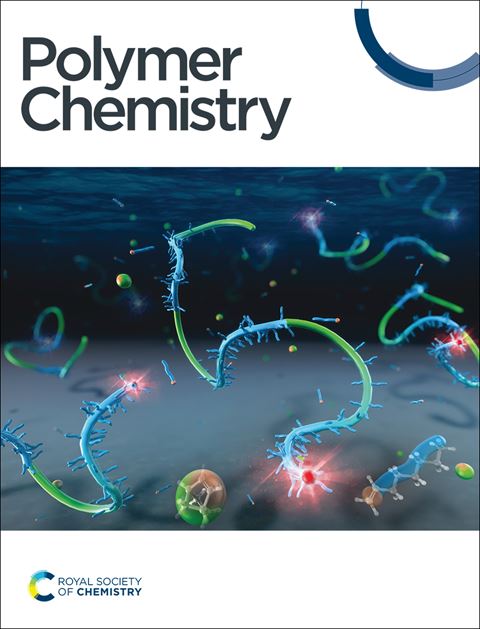高效光催化制氢用施受体型共轭多孔聚合物/g- c3n4s型异质结的构建
IF 3.9
2区 化学
Q2 POLYMER SCIENCE
引用次数: 0
摘要
合理设计电荷输运机制是构建高效的聚合物异质结光催化制氢催化剂的关键。本研究采用溶剂分散法,将不同比例的g-C3N4与DBDSO混合,合成了一系列DBDSO/g-C3N4-x (x=10、15、20、30)复合材料。以二苯并噻吩- s, s -二氧化二苯并噻吩(DBTSO)与4,8-二(噻吩-2-基)苯并[1,2-b:4,5-b ']二噻吩(DBD)为原料,通过Suzuki偶联反应合成了供体-受体(D-A)型共轭多孔聚合物(CPP),命名为DBDSO。光电测量和理论模拟表明,S-scheme PHJs的形成促进了光生成载流子的有效分离和传输,导致荧光寿命从纯g-C3N4的3.78 ns减少到DBDSO/g-C3N4-15复合材料的2.63 ns。结果表明,与未添加贵金属助催化剂的纯g-C3N4催化剂相比,DBDSO/g-C3N4-15的PHP性能得到了显著提高,析氢速率(HER)达到80.75 mmol·g-1·h-1。此外,DBDSO/g-C3N4-15在420 nm波长下表现出良好的光催化稳定性,表观量子产率为3.88%。这项工作提出了一种有前途的方法,通过合理的结构设计来调节电荷转移来增强光催化HER。本文章由计算机程序翻译,如有差异,请以英文原文为准。

Construction of the donor–acceptor type conjugated porous polymer/g-C3N4 S-scheme heterojunction for efficient photocatalytic hydrogen production†
The rational design of charge transport mechanisms is crucial for constructing efficient catalysts with polymer heterojunctions (PHJs) for photocatalytic hydrogen production (PHP). In this study, a series of composites DBDSO/g-C3N4-x (x = 10, 15, 20, and 30) were synthesized by combining different proportions of g-C3N4 with DBDSO using the solvent dispersion method. The donor–acceptor (D–A) type conjugated porous polymer (CPP), named DBDSO, was synthesized through the Suzuki coupling reaction between dibenzothiophene-S,S-dioxide (DBTSO) and 4,8-di(thiophen-2-yl) benzo[1,2-b:4,5-b′] dithiophene (DBD). Optoelectronic measurements and theoretical simulations revealed that the formation of S-scheme PHJs facilitated efficient separation and transport of photo-generated carriers, resulting in a decrease in fluorescence lifetimes from 3.78 ns in pure g-C3N4 to 2.63 ns in the DBDSO/g-C3N4-15 composite. As a result, DBDSO/g-C3N4-15 exhibited significantly enhanced PHP performance compared to pure g-C3N4 catalysts without any precious metal co-catalyst addition, achieving an impressive hydrogen evolution rate (HER) of 80.75 mmol g−1 h−1. Additionally, DBDSO/g-C3N4-15 demonstrated good photocatalytic stability with an apparent quantum yield of 3.88% at a wavelength of 420 nm. This work presents a promising approach for enhancing the photocatalytic HER through rational structural design to regulate charge transfer.
求助全文
通过发布文献求助,成功后即可免费获取论文全文。
去求助
来源期刊

Polymer Chemistry
POLYMER SCIENCE-
CiteScore
8.60
自引率
8.70%
发文量
535
审稿时长
1.7 months
期刊介绍:
Polymer Chemistry welcomes submissions in all areas of polymer science that have a strong focus on macromolecular chemistry. Manuscripts may cover a broad range of fields, yet no direct application focus is required.
 求助内容:
求助内容: 应助结果提醒方式:
应助结果提醒方式:


